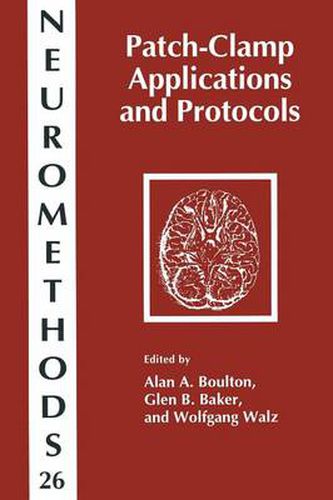Readings Newsletter
Become a Readings Member to make your shopping experience even easier.
Sign in or sign up for free!
You’re not far away from qualifying for FREE standard shipping within Australia
You’ve qualified for FREE standard shipping within Australia
The cart is loading…






This title is printed to order. This book may have been self-published. If so, we cannot guarantee the quality of the content. In the main most books will have gone through the editing process however some may not. We therefore suggest that you be aware of this before ordering this book. If in doubt check either the author or publisher’s details as we are unable to accept any returns unless they are faulty. Please contact us if you have any questions.
E. Neher and B. Sakman were the first to monitor the opening and closing of single ion channels and membranes by conductance measurements. In 1976, they used firepolished micropipets with a tip diameter of 3-5 pm to record currents from a small patch of the membranbe of sk- etal muscles, thereby decreasing background membrane noise. In order to reduce the dominant source of background noise-the leakage shunt under the pipet rim between m- the muscle membrane had to be treated brane and gla- enzymatically. Despite these early limitations, a new te- nique was born -the patch-clamp technique. The final bre- through came in 1981 when the same authors, in collaboration with 0. P. Hamill, A. Marty, and F. J. Sigworth, developed the gigaohm seal. Not only did this improve the quality of recordings, it was now possible to gently pull the membrane patch with the attached pipet off the cell and study its trapped ion channels in isolation. Another offshoot of the gigaohm seal technique was the whole-cell patch-clamp technique, in which the patch is ruptured without breaking the seal. This technique is really a sophisticated voltage-clamp technique and also allows for the altering of cytoplasmic constituents if the experimenter so wishes. The first part of Patch-Clamp Applications and Protocols presents modern developments associated with the techn- ogy of patch-clamp electrodes, of cell-free ion channel reco- ing, and of the whole-cell patch-clamp technique.
$9.00 standard shipping within Australia
FREE standard shipping within Australia for orders over $100.00
Express & International shipping calculated at checkout
This title is printed to order. This book may have been self-published. If so, we cannot guarantee the quality of the content. In the main most books will have gone through the editing process however some may not. We therefore suggest that you be aware of this before ordering this book. If in doubt check either the author or publisher’s details as we are unable to accept any returns unless they are faulty. Please contact us if you have any questions.
E. Neher and B. Sakman were the first to monitor the opening and closing of single ion channels and membranes by conductance measurements. In 1976, they used firepolished micropipets with a tip diameter of 3-5 pm to record currents from a small patch of the membranbe of sk- etal muscles, thereby decreasing background membrane noise. In order to reduce the dominant source of background noise-the leakage shunt under the pipet rim between m- the muscle membrane had to be treated brane and gla- enzymatically. Despite these early limitations, a new te- nique was born -the patch-clamp technique. The final bre- through came in 1981 when the same authors, in collaboration with 0. P. Hamill, A. Marty, and F. J. Sigworth, developed the gigaohm seal. Not only did this improve the quality of recordings, it was now possible to gently pull the membrane patch with the attached pipet off the cell and study its trapped ion channels in isolation. Another offshoot of the gigaohm seal technique was the whole-cell patch-clamp technique, in which the patch is ruptured without breaking the seal. This technique is really a sophisticated voltage-clamp technique and also allows for the altering of cytoplasmic constituents if the experimenter so wishes. The first part of Patch-Clamp Applications and Protocols presents modern developments associated with the techn- ogy of patch-clamp electrodes, of cell-free ion channel reco- ing, and of the whole-cell patch-clamp technique.